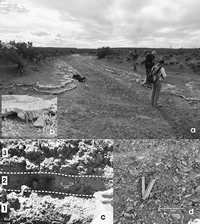Coastal landscape evolution and sea-level change: a case study from Central Patagonia (Argentina)
Pappalardo M., M. Aguirre, M. Bini, I. Consoloni, E. Fucks, J.C. Hellstrom, A. Ribolini, I. Isola, G. Zanchetta (2015).
Zeitschrift für Geomorphologie, Volume 59, Issue 2 , Pages 145-172 doi:10.1127/0372-8854/2014/0142.
Abstract
The coastal fringe of Central Patagonia preserves a unique and spectacular succession of landforms discontinuously formed since MIS 11 up to the Holocene. The study area, stretching from 44° 34′ to 44° 54′ S of latitude, is crucial to analyze the complexity of multitemporal shorelines formation and preservation along the Atlantic coast of South America. We used depositional and erosional landforms to get reliable and well chronologically constrained sea level markers. In particular, multistoried swale infillings, produced by a complex relationship between river discharge and marine activity, were considered the most accurate sea level markers. Palaeo sea level elevation was assessed cross checking evidence obtained from different marker types and considering the original position of each of the measured features with respect to its contemporary sea level. A dedicated field measurement of the markers current elevation was necessary, considering the macrotidal regime that currently affects this coastal area. Literature and new data provide an excellent set of dating, useful to chronologically constrain all the palaeo shorelines that have been identified. On the whole five sea level highstands have confidently been referred to Holocene (maximum transgression peak), MIS 5, 7, 9 and 11. Sea level elevation for each of them was stated respectively at 2.5, 7.5, 10.5, 22.5 and 32.5 m a.s.l., but different error bars and levels of accuracy are assigned to each of these estimates, based on innovative criterions that are widely discussed in the text. Our work enabled us to obtain new, self-consistent values of the last 400 ka uplift rates for this coastal tract and to compare them with those calculated by other authors, suggesting for the investigated time span a moderate coastal uplift.


